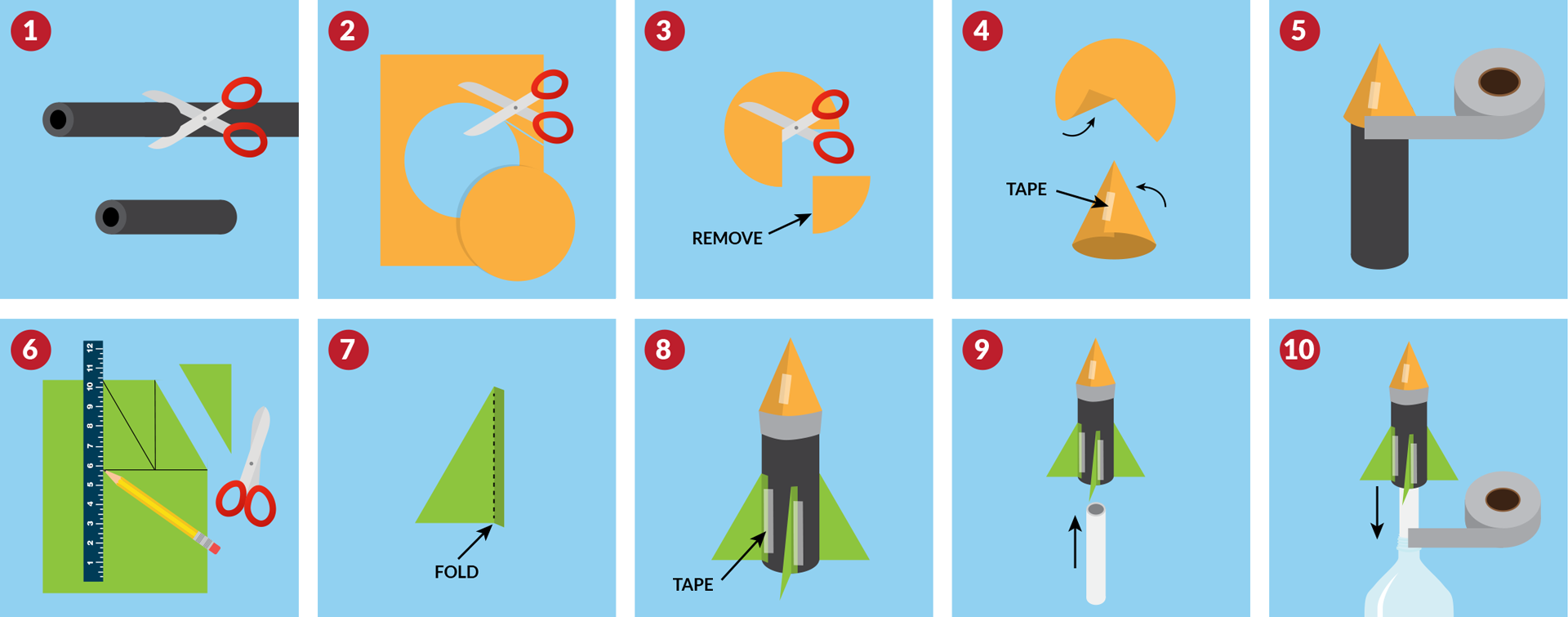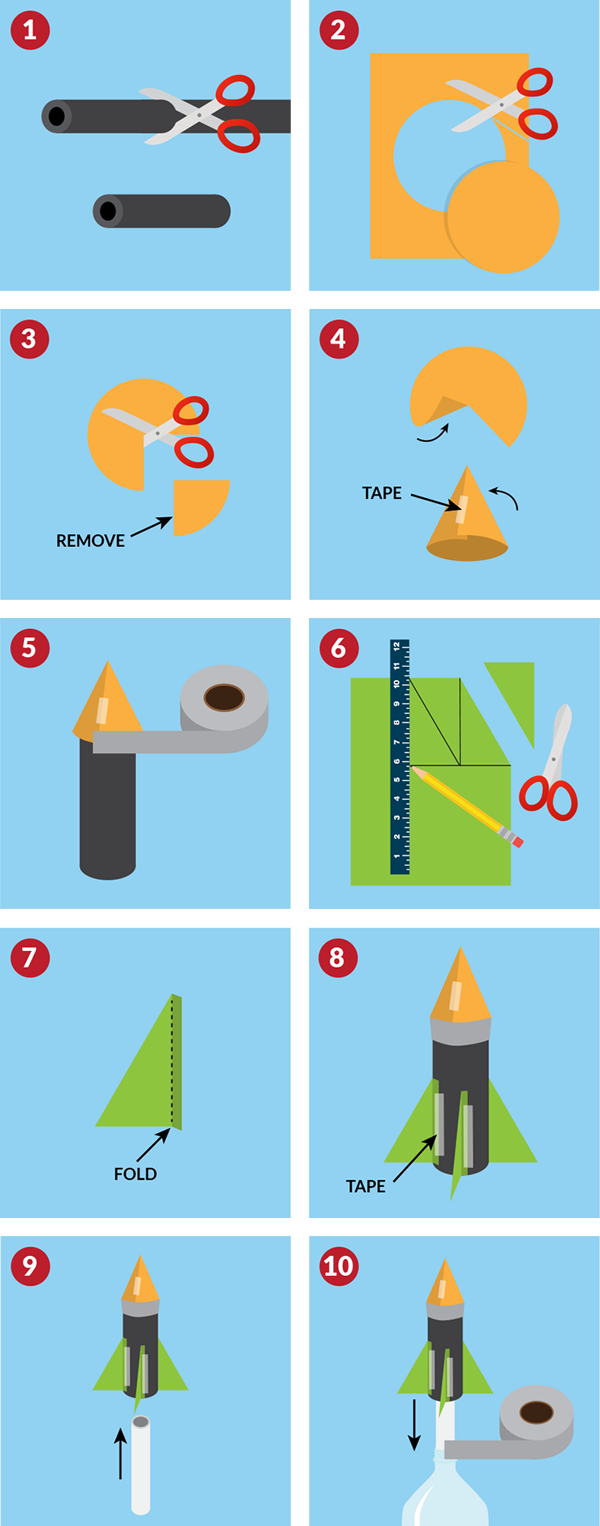Air Pressure Rockets
- Advanced
- Not Messy
- 60 Minutes
- Outdoor
Ready for liftoff?
Can you make a rocket and figure out how to launch it without any fuel? Try it!
Watch the video on YouTube: https://youtu.be/mSe-F3ByDhc
You Will Need
1-3 feet of 1/2 inch PVC pipe (pre-cut into 6, 10 inch sections)
1-3 feet of 3/4 inch pipe insulation
2-5 PVC pipe connectors (curved and straight)
1-4 empty 2-liter plastic bottles
Scotch tape
Duct tape
Construction paper
Pencil
Ruler
Scissors (adult supervision required)
Safety goggles
Directions
- Rocket Body:
- Cut ¾-inch pipe insulation into 6” sections. (Adult supervision required.) You will only need one 6” section for the body of each rocket you make.
- Nose Cone:
- Using scissors, carefully cut a circle (5 – 7” in diameter) from the construction paper.
- Cut out a section of approximately 90 degrees from the circle . (Adult supervision required.)
- Twist the remaining piece into a cone and fasten the side with scotch tape.
- Attach the cone to the end of the rocket body with duct tape.
- Fins:
- Using a pencil and a ruler, draw 3-4 triangles or “fins” of exactly the same size and cut them out.
- Fold one of the sides of each triangle to form a flap.
- Attach each fin to the bottom third of the rocket body using scotch tape.
- Launcher:
- Take one 6-10” section of PVC pipe and place it inside the rocket body.
- Place the other end of the PVC pipe section inside your 2-liter bottle. Secure this end to the bottle with duct tape. (Be sure to blow air into your 2-liter to maximize air pressure before taping it to your rocket.)
- Experiment Time:
- Your rocket and rocket launcher are ready! Apply pressure to the 2-Liter bottle to launch your rocket! You can squeeze it, jump on it, or create a giant rocket launcher with your friends! (WARNING: AIM THE ROCKET AWAY FROM ALL PEOPLE PRESENT TO ENSURE NO ONE GETS HURT.)
Experiment Extensions Try Making a Multi-Rocket Launcher:
There isn’t a straightforward process for this since you can use your own ideas and creativity to come up with the exact design for your super duper rocket launcher! We have a few suggestions and guidelines below to help guide your thinking:
Consider the following questions when brainstorming the design for your multi-rocket launcher:
- How many rockets do you want to launch? (We suggest using one 2-Liter bottle per rocket.) Do you want to launch your rocket at an incline? (Tip: Use a PVC Pipe connector to do this.) Do you have enough of each material to make your launcher and all the rockets you will need?
- You can use our original rocket-making instructions to make the rockets for your launcher, or try to vary the shape and size of the nose cone and fins to see if these factors impact your rockets’ flying ability!
- When connecting the different pipes in your launcher design together, use the PVC pipe connectors. (Not using the connectors may cause the air pressure to leak, leading to a slower launch of your rocket.) Once everything in your design is finished, duct tape all straight connectors to ensure your design is airtight. (Curved connectors do not need to be taped.)
WARNING: Before trying any launches, make sure your rocket is facing in a safe direction away from people and fragile objects!
Discovery Questions
Beginning the Experiment
- How do rockets get into the sky?
- If there is a force (thrust) that can overcome the weight of the rocket and the drag on the rocket, we have liftoff! This force is usually produced by burning a fuel or, in this case, air pressure.
- What does the nose cone do for the rocket?
- The nose cone helps reduce the air resistance that pushes against the front of the rocket.
- What is the purpose of the fins on the rocket?
- The fins stabilize the rocket and allow it to fly in the right direction without wobbling or rolling.
During the Experiment
- Are the weather conditions affecting the rocket launcher?
- This answer depends on the scientist, but weather conditions will affect how well your rocket flies.
- What kind of pressure is showing to be most effective in making the rocket go farther?
- This will depend on what methods the scientist is using to create the pressure, but generally, the more pressure you apply the farther your rocket will be able to go!
- Does the position of the rocket body on the PVC pipe have an effect on the experiment?
- The fit of the rocket around the PVC pipe must be snug in order to create the compressed air rocket system. If the rocket is too far up the PVC pipe there may not be a tight enough fit.
After the Experiment
- How does the 2-liter bottle help the rocket soar into the air?
- Pressing the air out of the 2-liter bottle creates air pressure that causes the rocket to accelerate.
- Do the sizes of fins matter?
- Yes. There are many factors that engineers consider when designing fins for rockets and planes – size is definitely one of them!
- How can weight affect the distance a rocket will fly?
- The forces pushing your rocket up will need to overcome the weight of the rocket in order to get it flying. The heavier your rocket is the more upward thrust you will need.
- To stabilize the rocket, fins were applied. Does the fin placement matter? What would happen if you placed the fins near the nose cone?
- Yes, fin placement matters a great deal! Since the side with the fins will have more drag on it, if the fins were placed towards the nose cone the rocket could tumble or flip!
How it works
The rocket is connected to a 2-liter bottle by a hollow PVC pipe that is taped into the bottle. This combination of the bottle and pipe is called the “launcher.” The 2-liter bottle is used to pressurize the inside of the PVC pipe to provide thrust for the rocket.
The other part of the compressed air rocket system is the rocket itself. The rocket has a hollow body tube which is opened on one end and closed at the other end by the nose cone. Since the body tube is only slightly larger than the launch tube (PVC pipe), when the rocket is placed on the launch tube, the rocket body becomes a closed pressure vessel. The pressure inside the body tube equals the pressure produced by the air pressure in the bottle.
Fins are attached to the bottom of the rocket to provide stability during the flight.
Unlike a model rocket or full-scale rocket for which the thrust force is applied to the rocket for a large portion of the flight, the thrust of an air pressure rocket is completely expended in the first few seconds of flight. During the entire flight, only gravity and aerodynamic forces act on the rocket.
The launch of a compressed air rocket proceeds in three stages; the pressurization of the body tube, the initial acceleration along the launch tube, and the expulsion of the compressed air from the rear of the rocket. These three stages provide the thrust necessary to send your rocket flying!
Key Words
- Air Pressure
- The force of air over a given area. Given the same force, the smaller the area of contact, the more pressure is applied.
- Conduit
- A means of transmitting or distributing
- Thrust
- The force that moves an aircraft or rocket through the air. It is usually generated by accelerating a mass of gas in the opposite direction of desired flight.
- Fuel
- Material such as coal, gas, or oil that is burned to produce heat or power.
- Launch
- The act of starting or setting an object or activity in motion.
- Force
- Strength or energy as an attribute of physical action or movement.
- Aerodynamics
- The study of air in motion and the forces that act on solid surfaces moving through the air.
- Pressurization
- Maintenance of near-normal atmospheric pressure during high-altitude or spaceflight.
- Acceleration
- The rate of change of the velocity of an object


